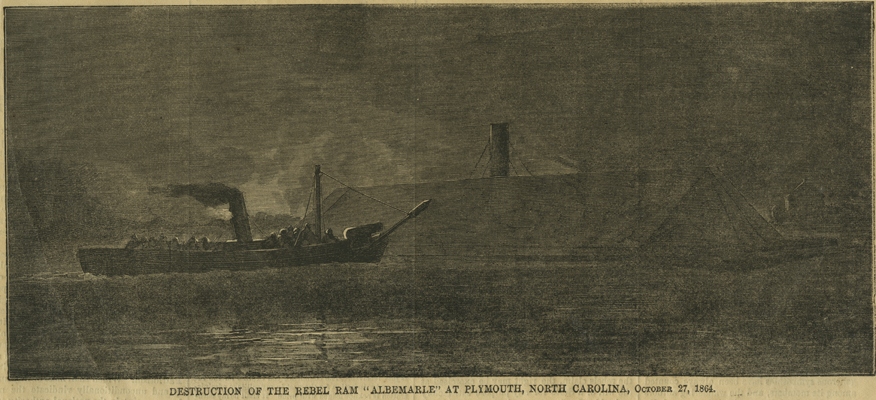CSS Albemarle
Featured Character – 1864 Confederate
Decline

Destruction
of the Rebel
Ram "Albemarle" at Plymouth, North Carolina, October 27, 1864. Harper's
Weekly, November 19, 1864, page 1
Courtesy of the Museum of the Albemarle
In
1862, Confederate authorities initiated a plan to challenge
Union naval superiority on the sounds and rivers of eastern North Carolina. They commissioned
construction of three large
ironclads on each of the state’s major East-West rivers. Due to funding and supply
problems, only the
projects on the Roanoke
and Neuse
Rivers
actually reached the construction phase.
For the Roanoke River
ironclad, the
Confederate Navy selected nineteen-year old Gilbert Elliott as
principal
contractor. An
officer in the 17th North
Carolina Infantry and a native of Elizabeth City,
Elliott came from a
shipbuilding family. He
selected a
cornfield near Edwards Ferry in Halifax County as
the
shipyard. Elliott
fought shortages of
skilled labor, timber and iron bars.
Despite the difficulties, by early 1864 the ironclad,
commissioned as
the Albemarle,
was ready to be launched. With
workmen still onboard, the ram embarked
on April 18, 1864 for her rendezvous with the Union fleet at Plymouth.
Early the next morning, the Albemarle
sank
one Union gunboat, severely damaged another, and forced the Union navy
to
retreat down the Roanoke River. With support from her
guns, Confederate
General Robert F. Hoke forced the Union garrison in Plymouth
to surrender. Fresh
with success, the Confederate
commanders decided to use the Albemarle
against
the main Union defenses at New Bern. Although they suffered
major damage, the Union gunboats Sassacus, Wyalusing,
Mattabesett, Commodore Hull, and Ceres,
at the Battle of Batchlor’s Bay on May 5, 1864 managed to keep the ram from breaking out into the Albemarle
Sound. Confederate
forces failed to
retake New Bern, but
the Union navy worried
about the potential threat of the Albemarle. On the night of October
27, 1864, naval
lieutenant William B. Cushing mounted a daring raid on the Albemarle. Using a steam-powered
launch armed with an
explosive torpedo, Cushing managed to sink the ironclad at her moorings
in Plymouth. With the ram now
neutralized, Union forces retook
the town. Refloated
by the Union navy,
the Ceres towed the Albemarle
to Norfolk Navy Yard in April 1865.
They
sold her for scrap in October 1867.
